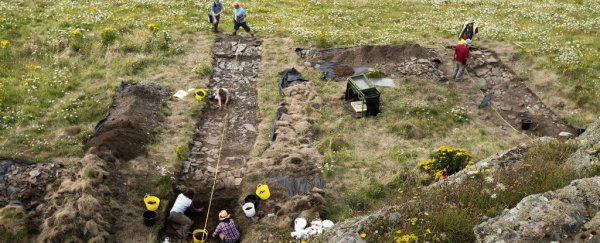British archaeologists have reported the discovery of massive walls that appear to be part of a Dark Ages palace complex that existed around the same time and place as King Arthur's birthplace in the famous legend of Camelot.
The walls, located in the English village of Tintagel in southwest Cornwall, enclose a number of buildings that would have formed the royal centre of the Kingdom of Dumnonia in the 5th and 6th centuries AD, experts suggest.
The dozen or so buried buildings discovered inside the 1-metre-thick (3-foot) masonry walls contained hundreds of fine glass fragments from medieval France and pottery shards from Late-Roman amphorae and Phocaean red-slip ware, thought to have carried wine from modern-day Turkey and olive oil from northern Africa.
The exotic origins of these artefacts suggest that whoever was living inside this building complex would have likely been very wealthy, and probably royalty.
"It isn't just a trading centre to move olive oil around, they're actually indulging in it, they're feasting here," one of the team, Winn Scutt from English Heritage, told BBC News.
So the elite probably lived here, but why do people think it could be King Arthur?
Well, first thing's first: the legend of King Arthur is exactly that - a legend. Despite the fact that the mythological figure has been wildly popular for centuries, no one's actually been able to prove he existed.
But what makes Arthur so intriguing is the way we can tie certain historical places and events to him. If we look at the original source of the Arthur legend, the author points to a fortress at the same site as the recently unearthed palace complex as being Arthur's birthplace.
As Jay Bennett reports for Popular Mechanics:
"Geoffrey of Monmouth, a 12th century Welsh cleric, recorded one of the first detailed written accounts of King Arthur's life in his Historia Regum Britanniae (History of the Kings of Britain), likely taken from earlier oral traditions.
In Geoffrey's account, completed around 1136, King Arthur was conceived in the 5th century in a fortress at Tintagel that had fallen into ruin by Geoffrey's time. The ruins of a castle that was completed about a century after Geoffrey lived still stand near the dig site where the Dark Ages buildings were discovered."
Geoffrey's account is also the origin of famous details of Arthur's life, including his friendship with the wizard Merlin, and when he pulled a sword from a stone.
To make things even more interesting, a slate engraved with "Artognou", Latin for the English name Arthnou, was uncovered at the site back in 1998.
The myth of King Arthur states that during the 5th or 6th century, he managed to unite the Britons so they could fight off the invading Anglo-Saxons and bring about the peaceful age of Camelot.
Historians generally agree that these events did actually happen, but whether or not a king named Arthur orchestrated them has yet to be proven. Although the legend states that he won some 12 battles against the Anglo-Saxons, his name does not appear anywhere in the only surviving contemporary history of the invasion.
As Bennett explains, "Skeptics will … point to the fact that Geoffrey was writing some 600 years after King Arthur's alleged death, suggesting that the myth of Arthur was likely patched together from the lives of many historical rulers."
The excavation of Tintagel, upon which still stands a medieval castle that was built almost 100 years after the recently uncovered fortress, will continue, and the results of the excavation will be published in the coming years.Maybe we'll find something concrete to tie it to the Arthur, but until then, the legend remains a legend.
